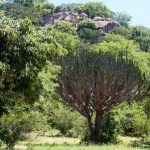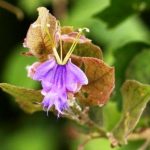TREE LIFE
MARCH 1996
Subs for the year l996/97are due on 1st April. Please attach the enclosed statement of account to your remittance when sending or handing it in.
NATIONAL BOTANIC GARDENS FENCING PROJECT
Come on, folks – we are nearly half way to our target of $3000.00. Tom’s circular will have put you completely in the picture. Perhaps you would like to round up your subscription payment to an easy $50.00 – you will not miss it and we will be most grateful for the extra $10.00.
MASHONALAND CALENDAR
Tuesday 5th March. Botanic Garden Walk at 4.45 for 5 p.m. We will meet Tom in the public car park of the Gardens, and continue where we left off last month. There will be a guard for the cars.
Sunday 17th March. Over the years Chegutu has become one of the Tree Society’s favourite areas, one which always has a surprise by way of the unexpected species or several which we do not often encounter on our outings. After these wonderful rains this trip to Graham and Maggs Speight’s Mkarati Farm is expected to be super.
Saturday 23rd March. For Mark’s Walk we will meet at 2.30 p.m. at the Domboshawa car park. This is always an interesting venue who knows what we will see after the rains.
Tuesday 2nd April. Botanic Garden Walk.
April 5th to 8th Easter. Accommodation for 18 has been reserved at Ezulwini in Nyanga. Fully booked, but phone Maureen in the evenings if you wish to be put on the waiting list.
Sunday 21st April. To be advised.
MATABELELAND CALENDAR
Sunday 3rd March. Chesa Research Station in Burnside. Morning only. Rendezvous at Girls’ College and depart at 8.30 a.m.
Monday 1st April. AGM at Girls’ College. 7.45 for 8.00 p.m. with a video on the Okavango afterwards. Notice is given that Ian McCausland and Sharon Brennan are not standing for re-election to the committee.
Monday 8th April. Please note we will not be going out on Easter Sunday but on Easter Monday instead. Details of the visit will be given in the next issue of Tree Life.
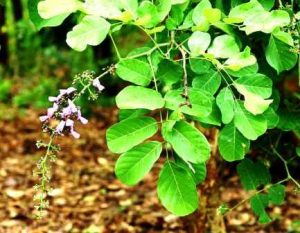
Millettia stuhlmannii. Photo: Bart Wursten. Source: Flora of Zimbabwe
There are two species of Millettia in Zimbabwe: Millettia stuhlmannii (the Panga-panga) and Millettia usaramensis. Both are growing in the Gardens and we were able to look at them. Both species have imparipinnate leaves, with opposite leaflets and quite prominent stipels near the points of attachment of the leaflets (features they share with Lonchocarpus).
Millettia is actually related to two other woody genera Craibia (leaflets alternate) and Mundulea (pods not woody).
Of the two species of Millettia, Millettia usaramensis is more of a shrub or small tree than the much larger Panga-panga. The flowers are in racemes and these were erect or spreading and not pendulous as in Millettia stuhlmannii. Furthermore, the leaflets of Millettia usaramensis are smaller than those of Millettia stuhlmannii. According to the Flora of Tropical East Africa, the technical character which separates them is that the standard is glabrous in Millettia stuhlmannii and is silky hairy in Millettia usaramensis.
A genus somewhat on the border of the two subfamilies Papilionoideae and Leguminosae is Xanthocercis, represented in Zimbabwe by the Nyala Berry. It is of course unusual in having a berry-like fruit. Tom mentioned that inside is a single shiny black seed. This tree occurs on alluvial soils in the lowveld (the very striking large trees as one approaches Birchenough Bridge come to mind) and also on anthills.
Abrus is unusual in having imparipinnate leaves. Abrus precatorius is a climber with numerous pairs of leaflets and very distinctive black and red seeds. Abrus schimperi, on the other hand does not possess these characters. It is rather a nondescript shrub, generally occurring at low altitudes with purplish pea-flowers.
Finally, we found Baphia massaiensis, a beautiful pinkish-white pea-flower. It has simple obovate leaves and occurs commonly in Kalahari sand forests and also in the Jesse. It is well known from near the Victoria Falls Hotel.
Once again, an extremely interesting walk and we thank Tom for sharing his knowledge with us.
-Mark Hyde
BOTANIC GARDEN WALK: 6th February, 1996.
Continuing with Leguminosae and the subfamily Caesalpinioideae, our walk with Tom covered a number of species, some of which being well known and of major economic value particularly Teak, Mukwa etc.
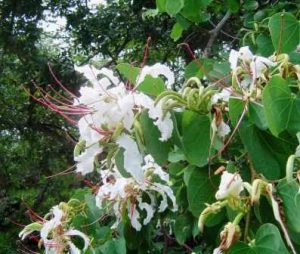
Bauhinia petersiana subsp. petersiana. Photo: Bart Wursten. Source: Flora of Zimbabwe
Included in this subfamily are the Bauhinia species which have a flower structure containing five petals which may be of varying lengths surrounding two whorls of ten stamens. The notched or almost divided leaf is a highly distinctive feature. Bauhinia petersiana subsp. petersiana which occurs in Miombo woodland at medium to low altitudes is a large spreading bush with a very attractive white flower with long crinkly white petals. The other subspecies Bauhinia petersiana subsp. macrantha is a more erect small tree found generally in Jesse. Bauhinia galpinii is a strong climber with a notched rather than a divided leaf and produces sprays of red flowers during the summer months. Well known as a garden subject it reaches its maximum in moist lowveld conditions. No longer classed as a Bauhinia but having similar features is Piliostigma thonningii, the differences being this species forms a full sized tree, the leaves are very large and leathery with a deep notch and the flowers are small and white. The large pods are a good source of protein for both livestock and game and Tom noted that these useful trees are rather difficult to propagate.
Guibourtia coleosperma is found in the Kalahari sands of northwest Zimbabwe and is often multi-stemmed. When young the bark is a smooth grey turning a liver colour and flaking when mature. The leaves are distinctive being a pair of a fat sickle shapes. These trees are often evergreen. Under a x 10 lens the small white flowers can be seen to consist of four to five sepals around a couple of whorls of stamens and there are no petals. The trade name for its timber is Copal wood and it is used for parquet flooring etc. Guibourtia conjugata on the other hand has a single trunk with a smooth grey bark. The leaves are smaller, shiny green and more rounded than the above and this gives the tree an unusually shiny appearance. It occurs on low altitude sandveld and has been used commercially despite being difficult to work.
Mopane – Colophospermum mopane is widely distributed in medium to low altitudes, such as from Beatrice with 800 mm rainfall per annum to Beitbridge with only 300 mm. However, better conditions such as deep soils and moisture produce the largest trees such as the ‘cathedral’ Mopane associated with the Zambezi Valley. Tom mentioned its association with poorly drained soils that have either a high clay content, are alkaline or sodic and where geological formations of laterite create a perched water table. The main features are the dark, deeply fissured bark, the paired ‘butterfly’ leaf, and flowers being similar to Guibourtia. The resin dotted flat seed can be used for the production of a hard resin such as gum copal but the Mopane worm is a major product. The hard, heavy red timber is used commercially but as the boles are often hollow the timber is often limited in size and usefulness.
The well known Teak, Baikiaea plurijuga shares a feature with Burkea africana and this is the growing tips are rusty red. The alternate leaves carry about five opposite leaflets of a distinctive glaucous green with a short yellow petiole. The large flowers, growing in a raceme, consist of five crinkly pink or mauve petals, four sepals and the expected ten stamens. Tom mentioned that as the Botanic Garden soils were not suitable this particular specimen was planted in a specially prepared hole filled with pink Gabbro soil from the Gokwe district.
One of the most widespread trees is Peltophorum africanum, which occurs in almost every habitat and is particularly noticeable during summer when it produces sprays of bright yellow flowers. As with the previous species there are five petals which have a wavy appearance. Another feature is the dark green bipinnate leaves with rusty growing tips and the flat pod containing one seed is also a distinctive feature.
Some of the features of the Brachystegia species include, flowers with two bracts and without petals occurring in small racemes but the spring colours or flush are probably the better known and vary from pinks through to deep coppery reds. An awkward feature about this group is that they hybridise easily with each other.
Starting with Brachystegia utilis which occurs in the Eastern Districts occupying areas outside of forests such as those in the Honde Valley. The leaflets are rounded and can resemble Mnondo – Julbernardia globiflora. From the Zambezi Escarpment comes Brachystegia allenii with its typically blue look and the leaflets twisting at right angles to the rachis. A specimen grows on the car park island at Marongora which we should see on the way to Rifa. According to Tom these trees seem to start better if grown in almost bonsai conditions, the tree roots spreading when the plant is ready to ‘get moving’. Brachystegia glaucescens is the distinctive feature of most rocky kopjies and has a smooth grey patchy bark. The leaves having up to 16 pairs of small leaflets were seen folded up for the night as some of the Acacia species do. This folding was also evident in Brachystegia microphylla, a smaller, more spreading tree with small finely spaced leaflets. This species also hybridises easily with other Brachystegia and occurs in the Eastern Districts. The last one covered being Brachystegia manga from the Kanyemba area of the Zambezi Valley, this particular species has four pairs of similar sized stiff blue-green leaves. Coates Palgrave notes this species as producing an extremely vivid spring flush.
Afzelia quanzensis, the Pod Mahogany, is a large tree with rounded crown found mainly in medium and low altitudes. The trunk has a grey flaky bark and the leaves are alternate and compound. The flower is a little different to those above as only a single large red petal with yellow veins is produced and distinctive black seeds with their red arils are to be found in the large flat pods. The hard wearing timber is used in a variety of applications.
Pterolobium stellatum, also known as Red Wing is a strong, well armed climber with hooked spines on both the bipinnate leaves and on the stems. Flowers occur in spikes and the mature fruit is red and flat hence its common name. It occurs in riverine and areas of higher rainfall.
The Tamarind, Tamarindus indica is a large spreading evergreen tree often associated with the Zambezi Valley and Escarpment. The bark is dark and has a coarse texture. Attractive red flowers consisting of five petals, the three upper ones being dominant. The fruit has the shape of a small, necked sausage and the pulp is edible and somewhat chewy. Alternate leaves which have a compound structure support finely spaced opposite pinnae. It is regarded as an indigenous species and occurs through Africa and into India.
Erythrophleum africanum, a lowveld species with this particular one having its ancestry in the Nyoni Hills and is more typical of the Mimosoideae as it produces a thin slender pod. The bark is dark and fissured and the leaves are bipinnate and compound with alternate leaflets covered with soft hair. This is the fabled Ordeal Tree from which a toxin is extracted from the bark. This species is avoided by elephants.
Moving back to Papilionoideae and something I’ve not seen before was Sophora velutina subsp. zimbabweensis, shrub-like with alternate compound leaves having 10 alternate pairs and a terminal leaflet. Lastly we looked at Cordyla africana, known also by the common name of African Mango, which is one of the few legumes producing a fleshy fruit, in this case large, yellow and spherical. The leaves are dark green and carry up to 28 pairs of opposite or alternate leaflets plus a terminal one. Flowers consist of a mass of yellow stamens produced in heads and laden with nectar.
Once again many thanks to Tom for a most interesting and enjoyable botanic walk
-Andy MacNaughtan
PTEROCARPUS – THE BROADER PICTURE
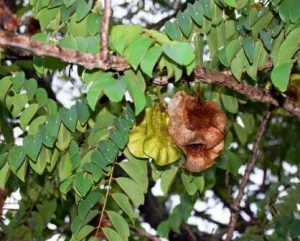
Pterocarpus angolensis. Photo: Stefaan Dondeyne. Source: Flora of Zimbabwe
During our monthly Botanic Garden walk with Tom Muller on Tuesday, 6 February, we had a look, among other things, at several of our Pterocarpus, species, including the well-known Mukwa, Pterocarpus angolensis, which is known as kiaat in South Africa and muninga in East Africa. But Pterocarpus is far from being a purely southern African, or even African, genus. There are about 20 species stretching from southern Africa, through east and West Africa to India, Malaysia, and the Far East. A number of them produce fine cabinet timbers and/or commercial Kino, a dark red, resinous exudation that is used as an astringent and in tanning. Aside from Mukwa, other commercially important species are:
Pterocarpus dalbergioides from the Andaman Islands in the Bay of Bengal; the wood is marketed as Andaman padauk, and at 790 kg/m3 it is about 23% heavier than Mukwa (640 kg/m3).
Pterocarpus erinaceus, West African rosewood, or bar-wood, furnishes a cabinet wood and a commercial Kino.
Pterocarpus indicus, from Burma south-eastwards into Indonesia, produces a very valuable cabinet wood that is known as Burmese rosewood, Andaman redwood, or amboyna, depending on country of origin. The wood is marginally heavier than Mukwa. I have seen specimens of Pterocarpus indicus planted in northern Queensland, instantly recognisable by the fruits, which look exactly like those of Mukwa, but less than half the diameter.
Pterocarpus macrocarpus, Burma padauk, from Burma and Thailand, produces a wood that is somewhat heavier (850 kg/m3) than our Zambezi Teak (815 kg/m3).
Pterocarpus marsupium, from India, is a most important producer of Kino, and it also furnishes a wood that is favoured for outdoor use, especially for door and window frames. The specific name of this tree really intrigues me!
Pterocarpus pedatus, maidu, from Vietnam, produces a very heavy wood (1010 kg/m3).
Pterocarpus osum and Pterocarpus soyauxii, from West Africa, produce African padauk, which varies from 640 to 800 kg/m3. They also furnish a dye used for body paint.
Pterocarpus santalinus, from the Malabar Coast of India, furnishes red sandalwood, a dark red, heavy wood used as a dyestuff. This species is identified by some commentators with the biblical algum and algum of 1 Kings 10:11-12, and 2 Chronicles 2:8, 9:10-11, and also with the sandalwood, citron wood, scented wood(s), rare woods, or thyine of Revelation 18:12. Not all commentators agree, of course. Red sandalwood must not be confused with the more famous Indian sandalwood, Santalum album, which furnishes scented oils, and is parasitic on Cassia spp.
-LYN MULLIN.
INTERNATIONAL TREE FOUNDATION
I was recently invited to meet Bishop John Neale of the International Tree Foundation (ITF), who was visiting Zimbabwe and who was staying with the Lange-Smiths at Ruwa. This was a most interesting meeting at which I was briefed on the activities of the ITF.
The ITF has in its membership both enthusiastic amateurs and professionals (foresters, for example). It publishes a journal and a newsletter and one of its roles is to act as an advisory body on matters related to trees to the British government and local authorities etc. It also has a thriving network of branches, mainly organised on a county basis, which consists of people interested in trees and who arrange tree-planting and visits to arboreta.
The ITF is keen to expand its international links. It is also planning to hold a conference, possibly in 1998, in the UK and, if possible, they would like members of our Society to attend. If any members would be interested in further details about this, or any other aspects of the ITF, please contact me.
-MARK HYDE.
Having been self-demoted to rank amateur status for not instantly recognizing Commiphora mollis, the writer gathered Norma and proceeded to Girls’ College 4 Feb.’96, on the way noticing a privet hedge (Ligustrum) in flower. On our return trip we recovered the inflorescence for study under the microscope. The first phase of this tree study was examining two tree specimens taken from Karna East the day before. The first was Carphalia pubescens with asymmetrical bracts (resembling Holmskioldia) without the inflorescence, with a much more extensive distribution than thought possible, the bracts at first resembling flowers, and being spectacular in appearance. The second was a trifoliate specimen, resembling a Rhus, but the inflorescence was a branched raceme (Allophylus africanus).
Mothering the group into position Ian directed us to Sandy Spruit in the Matopos, the water filled spruit defying crossing by vehicle. Dismounting, we ambulated along one side, until we reached a rocky area with narrowed stream, allowing us to jump across. On this rocky area we encountered Sesbania sesban, and a small tree Ochna schweinfurthiana. Along the way we found multiple Acacia, Acacia gerrardii, Acacia karroo, Acacia nilotica, Acacia fleckii, Acacia rehmanniana, and the most interesting puzzle of the entire day. This fairly well developed tree possessed recurved prickles, 13 pinnae, 25 leaflets, asymmetrical leaflet bases, lateral veins of leaflets not visible on inferior surface, petiole 1.3cm., and leaflets mostly 4mm in length. This last finding does not correspond with book in diagnosis of Acacia hereroensis which reports 2mm for leaflets. However, Jonathan said it was Acacia hereroensis, and so it shall remain, unless we come up with something different.
Combretum species found were Combretum hereroense, Combretum apiculatum, Combretum imberbe, and Combretum molle. Commiphora species were Commiphora mollis, Commiphora glandulosa and Commiphora pyracanthoides. Although our society classifies these last two as separate species, Trees of Southern Africa only reports them as subspecies. Next spring (1996) our group will have to come back to Karna East to see these two in flower, and examine the calyx to see if it is hairy or glabrous.
Further along, we encountered a tree with clusters of “cat-whiskers”, very beautiful with this floral demonstration (Clerodendrum glabrum); its partner Clerodendrum myricoides was frequently seen. The common fig trees in our area were present Ficus ingens, Ficus glumosa, and Ficus thonningii. Aloe excelsa was speckled about.
With, further peregrination, we split up into smaller groups finding Afzelia quanzensis, Albizia amara, Azanza garckeana, Kirkia acuminata, Burkea africana, Colophospermum mopane, Croton gratissimus, Ziziphus mucronata and Peltophorum africanum. Grewia monticola, Grewia bicolor, Grewia flavescens, and likely Grewia flava were identified. Rhus pyroides and Rhus leptodictya were seen. Terminalia sericea occurs ubiquitously; but we also found Terminalia randii and Terminalia trichopoda. “Small Honeysuckle Tree” was discovered tucked between some larger trees, also with its inflorescence peeping through (Turraea obtusifolia). Carissa edulis occurs every¬where, but we also found Carissa bispinosa, not often seen by our folks.
Wild Pear (Dombeya rotundifolia), Red Star Apple (Diospyros lycioides), Wisteria (Bolusanthus speciosus) and Live-Long (Lannea discolor) were found. One Tarenna neurophylla was visualised along with Ximenia caffra, Vangueria infausta and Psydrax livida.
Erythrina latissima with its multiple thorns and with leaf apex tapering were revealed, Euclea divinorum is found all over our area, but we also found Euclea natalensis and Euclea racemosa. I personally did not see Zanthoxylum capense and Gardenia ternifolia but others did. Other trees found were Flacourtia indica, Flueggea virosa, Tarchonanthus camphoratus, Strychnos madagascariensis, Markhamia zanzibarica, Maytenus senegalensis, Pappea capensis, Canthium lactescens, and Cussonia natalensis. Ehretia rigida, Sclerocarya birrea, Pouzolzia mixta, Ozoroa insignis, Piliostigma thonningii, Ormocarpum trichocarpum, Bridelia mollis, Elaeodendron matabelicum, Elephantorrhiza goetzei, Euphorbia matabelensis, Faurea saligna, and Diplorhynchus condylocarpon, Mukwa (Pterocarpus angolensis) and Round-leaved Kiaat were found.
We consider Tetradenia brevispicata and Maytenus heterophylla as shrubs on our tree list, but this is wrong because they grow to nine feet or over; I have seen Iboza 9 feet tall.
In the shrub category, we encountered Abutilon matopense, Cissus cornifolia, Euphorbia griseola, Lippia eylessii, Maerua juncea, Psidia punctulata, Rhoicissus tridentata, Sesbania macrantha and Strychnos matopensis.
We identified Clerodendrum teratum, Cleome hirta, Solanum (most likely Solanum panduriforme) Lannea edulis and others. We need a flower expert to teach us species of Albuca, Craterostigma, Xerophyta, Hypoxis, Commelina, (I found this genus in Texas last year), Ledebouria and Sansevieria. New names on this field trip were Tinnea rhodesiana and Cryptolepis cryptolepioides.
I vicariously attended the University of Natal, learning the palatability of Themeda triandra to wild animals, and about Panicum maximum and Sphacelata (I guess this is genus of Setaria), also new terms about Ecological status such as Decreaser and Increaser Hc. needs explanation.
-T. RAUB.
FOREST MAKES ITS TRUNK CALLS
Hugged a tree-trunk lately? If not, perhaps the tree will be able to console itself by talking to other trees growing nearby. In the depths of a primeval Japanese forest, groups of ancient trees are apparently in daily contact with each other, passing on information about their local environment, individual root territories, and goodness knows what else.
These “trunk calls” are the result of shared electrical biorhythms, maintains Yoshiyuki Miwa, a botanist at Waseda University in Tokyo. According to a recent report in the New Scientist, Miwa has monitored the “bioelectric potentials” of large numbers of trees by means of electrodes inserted into tree-trunks, and discovered that some groups of trees had “the same daily pattern of change”.
This he says shows that the trees are communicating electrically – via their roots. “Neighbouring trees were the most likely to be synchronised”, the report says, “but the groups did not have rigid boundaries. The membership of the groups was also not fixed… individual trees joined and dropped out”.
Miwa adds: “This could explain why some trees grow without entangling their roots” says Miwa. He suggests that a root switches its direction of growth if its field is influenced by that of another tree.
He hoes to strengthen the evidence for his findings by removing some members of a group and observing how this affects the remaining trees. If they respond strongly, as Miwa hopes to demonstrate, it would seem that this branch line is a forest force to be reckoned with.
-Bella Benson.
ANDY MACNAUGHTAN CHAIRMAN


